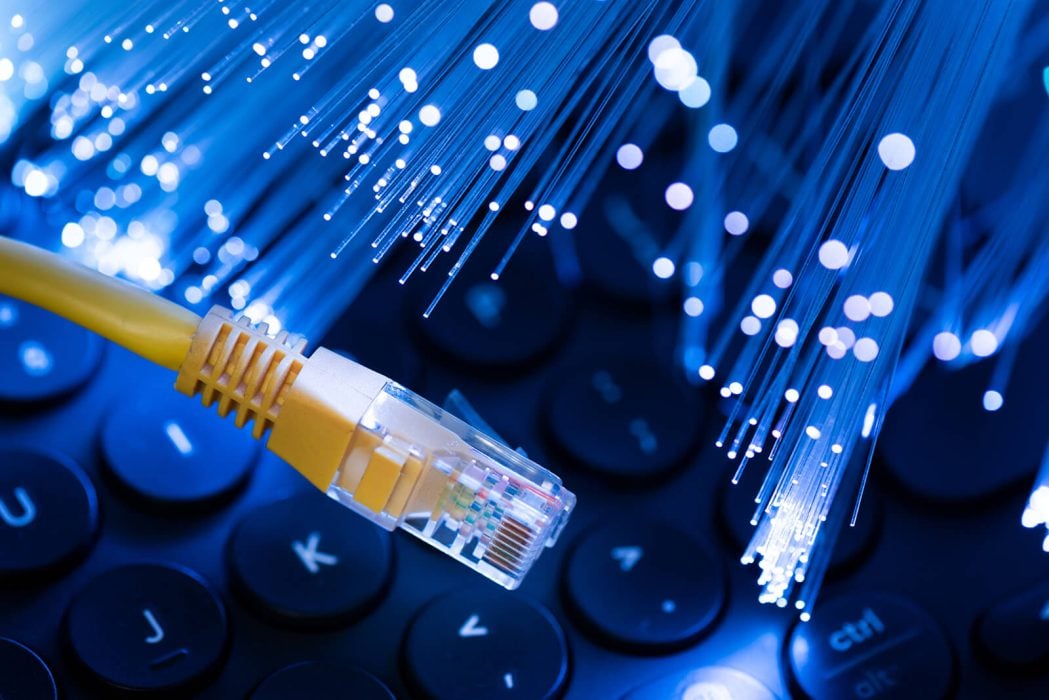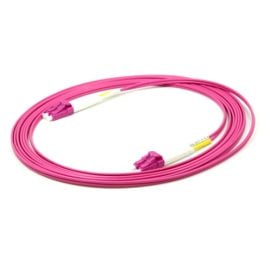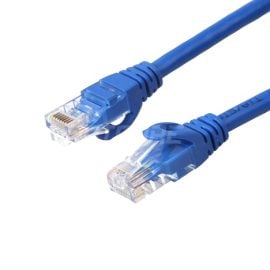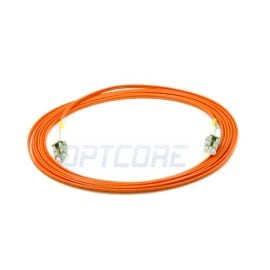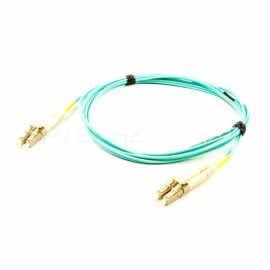Blog, Network Cabling
Broadband vs Fiber Internet: Which Is Better for Home?
The digital era has witnessed the fast development of broadband technologies. Have you ever been unsure about how to make the right choice between Broadband vs Fiber Internet? Which of these two is better for your home? This blog serves as a valuable guide, unraveling which option is better for you.
Table of contents
Broadband vs Fiber Internet: Definitions
Seen as a loyal companion by most households, broadband internet is an equivalent of their trustworthy steeds; however, fiber internet has played an increasingly important role in constantly reshaping internet technologies. Although you rely heavily on the frequent use of the internet, do you know its concrete definitions? This article will provide you with some basic knowledge of these two terms.
What Is Broadband Internet?
As its name indicates, broadband internet is an umbrella term for high-speed internet. It functions as an always-on internet connection that has the capacity to provide a wide range of data transmission.
Broadband internet enables its users to utilize a range of online services, obtain rapid access to desired resources, and enjoy watching videos and art exhibitions with fewer interruptions. Depending on different delivery technologies, broadband internet comes in four major types: cable internet, fiber internet, satellite internet, and DSL (Digital Subscriber Line) internet.
Cable internet utilizes the same infrastructure as cable television, allowing for high-speed connections through coaxial cables, and is available in both rural and urban areas. DSL internet is a technology that utilizes telephone lines to deliver internet service, making it easily accessible in rural regions. However, DSL internet is more susceptible to interference and weather conditions.
Satellite internet is typically an alternative for most remote or rural locations; however, it also features a certain degree of signal latency and can be easily impacted by changeable weather conditions.
Although a lesser-known internet service, fiber internet ensures data transmission through plastic or glass fibers. This kind of broadband internet is the fastest wired connection.
What Is Fiber Internet?
As briefly introduced in the previous section, fiber internet, which pioneers the digital highway, possesses the most potential in the digital world. Ideal for high-bandwidth applications, this internet has exceptionally low-speed latency. Due to the higher installation costs of infrastructure deployment, it is commonly available in most urban regions.
Additionally, fiber internet offers several advantages, including faster downloads and improved video streaming. The major drawback of this internet technology is that its use is restricted by availability.
Broadband vs Fiber Internet: Upsides and Downsides
This section mainly explains three types of internet services to help you decide between Broadband vs Fiber Internet. Considering that satellite internet relies on satellite signals commonly used in remote or rural areas, this section will not provide an additional explanation.
Pros and Cons of Cable Internet
Cable internet can ensure relatively high-speed connectivity by utilizing the same transmission facility as cable television, as it transmits data and information via coaxial cables with a large bandwidth capacity. For households eager to bundle their internet and cable service, cable internet may be a better choice, partly because cable wires offer a high-speed, reliable, consistent internet connection.
Cable infrastructure is widely available in most urban and suburban regions, so many users can have easy access to cable internet. Additionally, as cable providers typically offer bundles consisting of TV, cellphone, and internet services at relatively lower prices than purchasing each service separately, individuals seeking consistent and reliable connections can consider cable internet for their homes.
However, users exclusively purchasing the internet service will incur higher costs for internet-only plans. If multiple devices attempt to use the same internet service simultaneously, internet users may encounter slower speeds, especially during peak use periods. When the internet goes down, cable internet users might be charged additional installation fees.
Pros and Cons of DSL Internet
DSL internet uses existing telephone lines to establish internet connections, which are available in most rural areas where families do not employ other broadband services. Therefore, the first two advantages are the affordable price and widespread coverage, although DSL internet might have slower speeds than fiber and cable internet.
If you are a moderate internet user, utilizing this kind of internet is very appropriate. It allows you to browse the webpages, check emails, and watch standard-definition videos without serious interruptions. The reason is that you have a dedicated connection, and your internet can provide consistent speeds.
Limited bandwidth is an obvious disadvantage of DSL internet. When you engage in online gaming or use multiple devices heavily, the internet may react very slowly. The connection will become unreliable if your internet provider is far from your house.
Pros and Cons of Fiber Internet
The most prominent merits are exceptionally low-speed latency and the guarantee of reliable connections. Typically employed in big cities, fiber internet uses glass strands for data transmission as pulses of light, which means you can handle many tasks requiring heavy internet usage.
Besides, as the fiber is resilient to electromagnetic interference and extreme weather conditions, your internet connection can be highly reliable, and you don’t have to worry about focusing on your urgent tasks while you work from home.
Considered the fastest way to connect to the internet, fiber internet relies on an expensive medium, fiber, to transmit data. The costs may be very shocking to you, provided that your internet access requirements are moderate. Limited coverage and a relatively complex installation process are also demerits for users when choosing their internet.
Recommended Products
-
LC-LC 40/100GB OM4 Multimode LSZH Duplex Fiber Patch Cable
Price range: US$ 3.00 through US$ 73.00 (Excl. VAT) -
Cat6 Ethernet Network Patch Cable, Snagless Unshielded (UTP), PVC, Blue
Price range: US$ 0.85 through US$ 13.10 (Excl. VAT) -
LC-LC 50/125 OM2 Multimode PVC (OFNR) Duplex Fiber Patch Cable
Price range: US$ 2.90 through US$ 11.60 (Excl. VAT) -
LC-LC 10G OM3 Multimode Duplex LSZH Fiber Optic Patch Cable
Price range: US$ 2.80 through US$ 40.70 (Excl. VAT)
Broadband vs Fiber Internet: Which Is Better?
After comparing the upsides and downsides of the three kinds of internet, this section will mainly teach you how to select the appropriate internet type in four aspects.
Speed
Fiber internet, compared to the other two (cable internet and DSL internet) types, has the highest download and upload speeds and is ideal for high-bandwidth applications. The table below compares the download and upload speed ranges so you can easily understand.
| Connection Type | Download Speed Range | Upload Speed Range |
| DSL | 5 to 120 Mbps | 1 to 20 Mbps |
| Cable | 10 Mbps to 1 Gbps | 5 to 50 Mbps |
| Fiber | 200 Mbps to 20 Gbps | 200 Mbps to 20 Gbps |
Table: Download and Upload Speed Ranges of DSL, Cable, and Fiber Internet (Source from Broadbandnow)
DSL internet is the slowest of the three, but fiber internet occupies the predominant position. Although cable internet sits in the middle, it can race against fiber internet regarding gigabit-speed delivery. How to choose your internet depends much on your online activities, meaning that your attention is on slower or faster speeds.
Reliability
Reliability is crucial to measuring how your internet remains constant, consistent, and reliable under severe weather conditions. Simply put, the internet typically does not experience fluctuations from lower speeds to higher-speed connections.
Generally speaking, reliable internet options include both standard broadband and fiber internet. The latter provides more reliability when compared with the former because broadband connections can be severely affected by local circumstances. Fiber internet can maintain consistent performance due to its less susceptibility to electromagnetic interference and fewer restrictions on the distance from service providers.
Availability
It is a serious issue for households to consider the availability of different internet services, particularly when fiber-optic services fall short in some regions. Traditional broadband technologies use existing communication facilities (e.g., telephone lines, cable television, and satellites) for data transmission. Therefore, DSL and cable internet are more accessible to most rural or urban areas than fiber internet.
Fiber internet, most available in larger urban centers, is suitable for enterprises or households that require higher internet speeds. With the deployment of more fiber infrastructure, fiber internet will cover more locations across the country.
Common Tips
You have learned how to choose the right internet for your home mainly from three aspects, namely, speed, reliability, and availability. Here are some common tips for your better selection.
Household needs extremely count. You should carefully think about what speeds you need. Households with just a few family members and less dependent on the internet can choose the commonly used internet connections, such as cable and DSL. If you are in a quite large household with many family members on multiple devices, fiber internet should be your optimal choice.
Bandwidth capabilities also matter. Fiber internet has higher bandwidth capabilities than traditional broadband technologies, permitting the simultaneous transmission of massive data. Households that use multiple devices and have high internet usage may find it more beneficial to install fiber internet.
Privacy and security are equally important. If you want a more secure internet connection, consider taking fiber internet seriously. Self-employed workers who work from home should consider a fiber connection, as keeping information confidential is a top priority.
Budget setting and the price play an essential role. Suppose you do not have enough cash to install fiber internet at the fastest speed, reliable connectivity, and expensive installation costs. In that case, you can opt for alternative plans, such as DSL or cable internet. Keep in mind that whatever choices you have made are based on your balanced consideration of your budget and installation expenses.
Conclusion
Having read this blog, you may get the answer to the question of Broadband vs Fiber Internet: Which Is Better for Home? When making your decisions, please clearly identify your household’s needs, bandwidth requirements, and budgets, and compare the pros and cons of the three internet connection types mentioned above. You can find the most suitable internet for your home using this blog as your guide.
References







